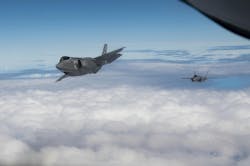Air Force reaches out to industry for model-based design in combat jet self-forming aerial networking
ROME, N.Y. – U.S. Air Force researchers are asking industry to develop on-demand, self-forming, and self-healing aerial networking to provide data and voice links to high-performance combat aircraft.
Officials of the Air Force Research Laboratory Information Directorate in Rome, N.Y., re-issued a broad-agency announcement (FA875023S7002) last week for the Aerial Layer Networking & Transmission Technologies project.
Today’s aerial layer networking requires significant pre-planning, and has limited interoperability, Air Force researchers explain. Instead, the Air Force wants to move to a significantly more on-demand, self-forming, and self-healing aerial layer network.
The Aerial Layer Networking & Transmission Technologies project will capitalize on research in network monitoring and management, robust aerial networks, and proof-of-concept capabilities.
Related: Air Force asking industry for manned and unmanned adaptive self-healing airborne networks
This project is a follow-on to the Air Force Timely, Secure & Mission Responsive Aerial Warfighting Network Capabilities project, which seeks to develop aerial networking for contested, degraded and operationally limited environments.
The project also seeks to develop capabilities to manage and plan today's multi-link based airborne network environment and tomorrow's dynamic ad-hoc opportunistic architectures using autonomous human-in-the-loop network management and recovery to improve network reliability and survivability.
These new capabilities should enable the Air Force to transform current aerial layer networking a ‘stitched together’ state to one that is truly seamless, adaptive, and mission- environmentally-aware.
Of particular interest are hardware and software development; validation with model-based design and simulation; and hardware-in-the-loop validation techniques.
Related: Kinetic mesh network brings aerial broadband connectivity, improved communications to UAS
Focus areas are airborne network management and monitoring; network technologies to improve network monitoring; self-managing and self-healing autonomic wireless network capabilities; robust airborne networking in apertures, waveforms, and networking; aerial network security; heterogeneous aerial layer networks; next generation mesh networking; ad-hoc tactical edge mesh networking; and enhanced network robustness, resilience, and availability.
This project will involve technology demonstrations using advanced radios, waveforms, networking, and management technologies; as well as low-cost demonstrations at Air Force facilities in Rome, N.Y. Funding will be about $99.5 million, and involve several 36-month contracts.
Companies interested should email white papers to the Air Force's Peter Fitzgerald, the Aerial Layer Networking & Transmission Technologies program manager at [email protected]. White papers for 2025 are due by 15 Sept. 2024, for 2026 by 15 Sept 2025, and for 2027 by 15 Sept. 2026.
Email technical questions or concerns to Peter Fitzgerald at [email protected], and business questions to Amber Buckley at [email protected]. More information is online at https://sam.gov/opp/90fac2ae38d04307b466694fb24e4c75/view.
About the Author
John Keller
Editor-in-Chief
John Keller is the Editor-in-Chief, Military & Aerospace Electronics Magazine--provides extensive coverage and analysis of enabling electronics and optoelectronic technologies in military, space and commercial aviation applications. John has been a member of the Military & Aerospace Electronics staff since 1989 and chief editor since 1995.
